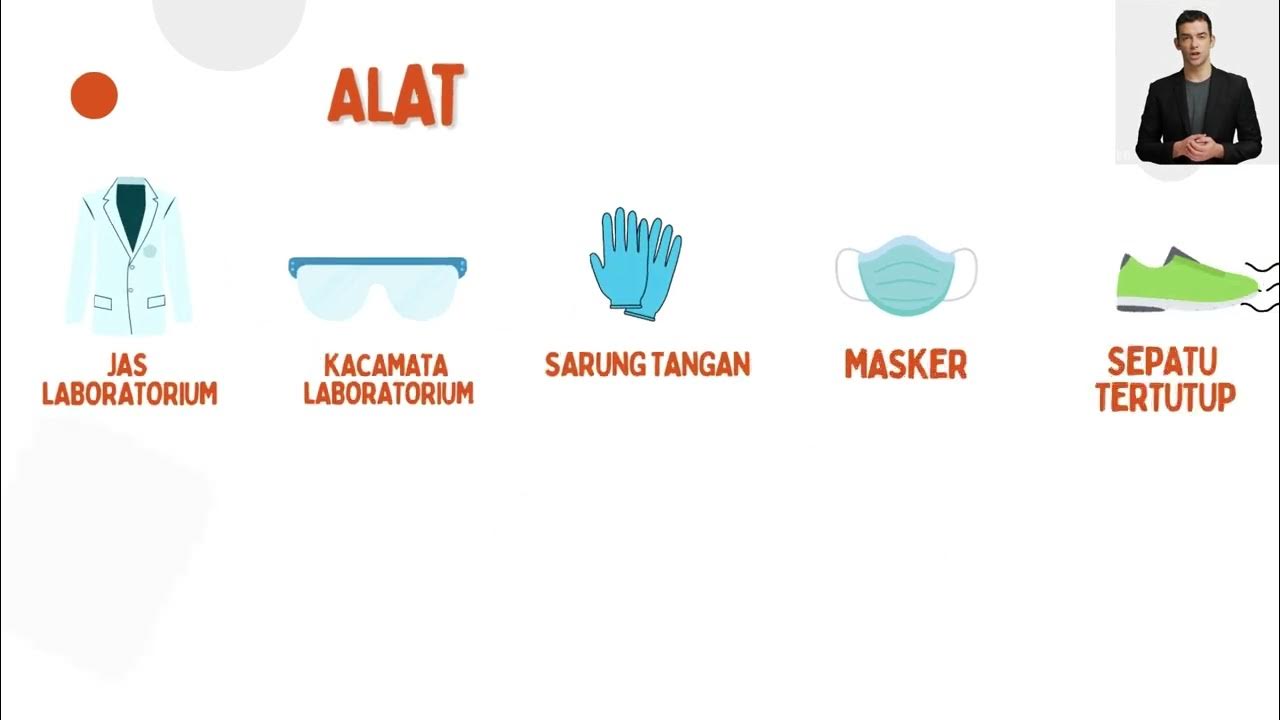Praktikum Kimia Dasar Modul 1. Pengenalan Alat Laboratorium
Summary
TLDRThis video introduces basic chemistry laboratory safety and procedures, emphasizing the importance of personal protective equipment (PPE), such as lab coats, gloves, and masks. It covers emergency protocols, including fire safety, chemical spills, and first aid for burns or injuries. The script also provides an overview of essential lab equipment, like beakers, pipets, volumetric flasks, and balances, along with tips for proper handling. Additionally, the video discusses the correct usage of fume hoods and laboratory ovens to ensure a safe and efficient working environment.
Takeaways
- 😀 Always wear appropriate safety gear in the lab, including a lab coat, gloves, mask, and closed shoes.
- 😀 Treat all chemicals as hazardous, regardless of their apparent risk, and handle them with care.
- 😀 Be aware of emergency procedures for accidents, including fire safety and chemical spills.
- 😀 In case of fire, stay calm, use the correct fire extinguisher, and notify the lab supervisor immediately.
- 😀 If chemicals spill on your skin, rinse with water immediately and wash with soap. Seek medical help for severe reactions.
- 😀 For eye contact with chemicals, rinse eyes under running water for at least 15 minutes and seek medical attention if irritation persists.
- 😀 Use a beaker for holding and heating liquids, but it's not suitable for accurate volume measurements.
- 😀 Use a graduated cylinder for precise liquid volume measurements, which are more accurate than a beaker.
- 😀 Erlenmeyer flasks are ideal for mixing and heating chemicals, especially during titration procedures.
- 😀 Always ensure lab equipment like balances and pipettes are calibrated properly before use to ensure accurate results.
Q & A
What are the essential safety protocols when working in a chemistry laboratory?
-The essential safety protocols include wearing a lab coat, gloves, mask, and closed-toed shoes. It’s also crucial to treat all chemicals as potentially dangerous and follow the laboratory's specific safety guidelines, such as knowing how to handle spills, fires, and accidents.
Why should chemicals be treated as potentially dangerous in the laboratory?
-Chemicals should be treated as potentially dangerous because many substances in the lab can be toxic, corrosive, flammable, or reactive. Adopting this mindset ensures that safety measures are followed, minimizing the risk of accidents and exposure.
What is the difference between a beaker and a measuring cylinder?
-A beaker is used to hold liquids or solids and can be used for heating, but it is not accurate for measuring volumes. A measuring cylinder, on the other hand, is specifically designed for measuring liquids with greater accuracy.
What should you do if you spill a chemical on your skin?
-If a chemical spills on your skin, immediately rinse the affected area with running water and wash it with soap. If the reaction persists or if the chemical causes a burn or irritation, continue rinsing with water and seek medical attention if necessary.
What is the proper way to handle a chemical fire in the laboratory?
-In case of a chemical fire, remain calm and avoid panicking. Use a fire extinguisher suitable for the type of fire (e.g., dry chemical or water) or report the fire immediately to the lab supervisor. Always know the location of fire safety equipment in the lab.
What are the functions of a burette in a chemistry laboratory?
-A burette is used in titrations to precisely measure and dispense a solution. Its graduated scale allows for accurate control over the volume of liquid released during the titration process.
What are the different types of pipettes mentioned in the script, and how are they used?
-The script mentions several types of pipettes, including volume pipettes, drop pipettes, and micropipettes. A volume pipette is used to measure and transfer exact amounts of liquid, while drop pipettes dispense liquids in drops. Micropipettes are used for very small volumes.
Why is it important to use a balance correctly in the laboratory?
-Correct use of a balance is crucial for measuring the precise amount of substances in experiments. It ensures accurate data for calculations and prevents errors in chemical reactions. Always ensure the balance is calibrated before use.
What should you do if a chemical splashes into your eyes?
-If a chemical splashes into your eyes, immediately rinse them with clean water from a eyewash station for at least 15 minutes. If irritation persists or the chemical is particularly hazardous, seek immediate medical attention.
How do you use a fume hood, and why is it necessary?
-A fume hood is used to safely conduct experiments involving volatile chemicals or substances that release harmful vapors. To use a fume hood, ensure that the sash is lowered to the appropriate level, and never exceed the maximum recommended capacity for chemicals. This helps contain fumes and prevent exposure.
Outlines

This section is available to paid users only. Please upgrade to access this part.
Upgrade NowMindmap

This section is available to paid users only. Please upgrade to access this part.
Upgrade NowKeywords

This section is available to paid users only. Please upgrade to access this part.
Upgrade NowHighlights

This section is available to paid users only. Please upgrade to access this part.
Upgrade NowTranscripts

This section is available to paid users only. Please upgrade to access this part.
Upgrade NowBrowse More Related Video

SAINS Tingkatan 4 KSSM I BAB 1 I Langkah Keselamatan di dlm Makmal I 1.1 Peralatan Perlindungan Diri

Aula Prática: EPI's e EPC's no Laboratório de Química

Keselamatan Kerja di Laboratorium | Tata Tertib & Simbol Bahan - Sains

Normas de segurança no laboratório de Química

Good Microbiological Practices and Procedures (GMPP) 1: personal protective equipment (PPE)

Keselamatan Kerja di Laboratorium IPA Mata Kuliah Pendalaman Materi IPA
5.0 / 5 (0 votes)